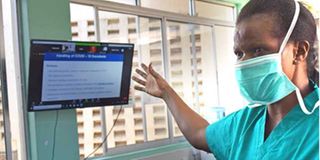Pain, suffering as blood crisis hits Nyanza’s biggest hospital

The nurse in-charge of Jaramogi Oginga Odinga Teaching and Referral Hospital shows one of the screens they have set up at the facility that will be used to minitor Corona Patients should the pandemic find its way to the lake city.
What you need to know:
- The gradual withdrawal of the US President’s Emergency Plan for Aids Relief (Pepfar) funding since 2014 and the failure by the government to plug the resulting gap have caused a crisis in regional and satellite blood banks.
- The Kisumu Blood Transfusion Centre has a capacity to store up to 5,000 units of blood, but it currently has less than 400 units.
When Ms Mary Amutabi, a resident of Vihiga, was referred to Jaramogi Oginga Odinga Teaching and Referral Hospital for dialysis two weeks ago, she did not anticipate to experience the challenges that come with acute blood crisis.
The Level Five facility, popularly known as ‘Russia’ by locals, has run out of blood, with patients like Ms Amutabi now forced to request their family members to donate blood.
The hospital’s CEO, Dr Peter Okoth, said the blood donations from patients’ relatives is not enough.
"Usually the blood from relatives is a small push for us. There is a likelihood of failing to get the compatible blood group for the patient,” Dr Okoth said.
He added: "There are those who do not have relatives to donate blood, where do they go to and they are the majority?"
Dr Okoth said they have planned a blood donation initiative scheduled for today (Thursday), adding that they are targeting to collect about 480 pints of blood.
The gradual withdrawal of the US President’s Emergency Plan for Aids Relief (Pepfar) funding since 2014 and the failure by the government to plug the resulting gap have caused a crisis in regional and satellite blood banks.
Funding for the Kenya National Blood Transfusion Service ceased last year.
The Kisumu Blood Transfusion Centre has a capacity to store up to 5,000 units of blood, but it currently has less than 400 units. Reduced funding has curtailed outreach programmes.
Regional Blood Transfusion Centre deputy director Mathew Odera told the Nation the Covid-19 pandemic has affected blood donations.
"We cannot full rely on blood donated by patients’ relatives. It becomes a challenge, with the limited number of blood units available to serve the whole region,” said Mr Odera.
The shortage of blood in regional and satellite centres has compelled some hospitals to run their own collections. Since the process is costly, hospitals pass the expenses to patients.
Regional blood banks
Last year, Kenya collected 164,000 units of blood against the World Health Organization (WHO) recommended minimum of one per cent of the population (480,000 units).
According to the WHO guidelines, the optimum requirement for Kenya’s population is 960,000 units per year.
The government set up six regional blood banks 20 years ago upon WHO recommendations to streamline the process of blood collection.
This led to a more structured collection, screening, storage and distribution of blood by the six banks in Nairobi, Embu, Nakuru, Mombasa, Eldoret and Kisumu.
The plan was heavily financed by Pepfar, which hoped the government would step in when the US ended the funding.





